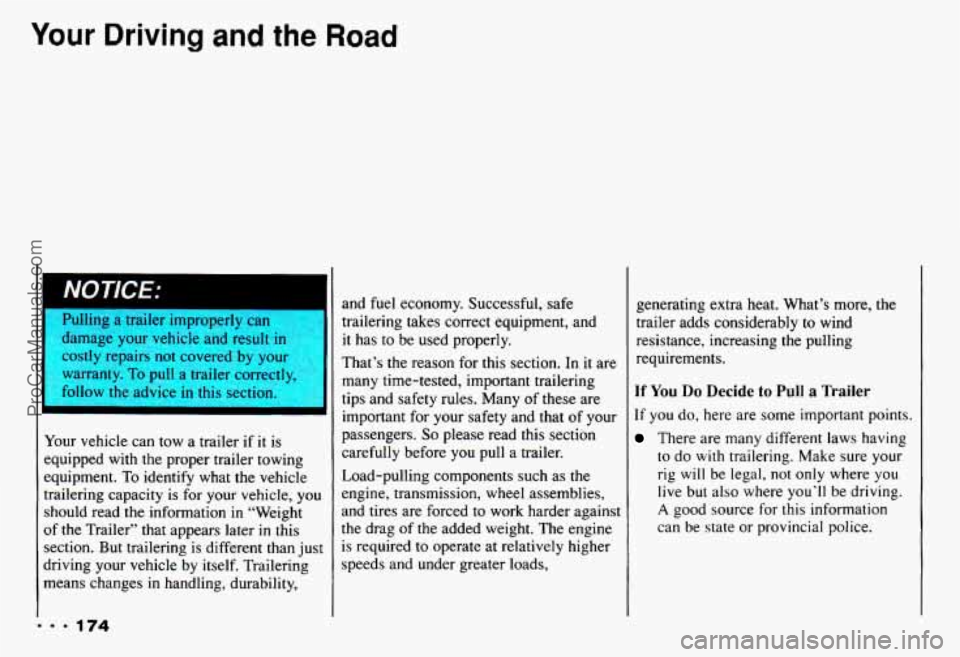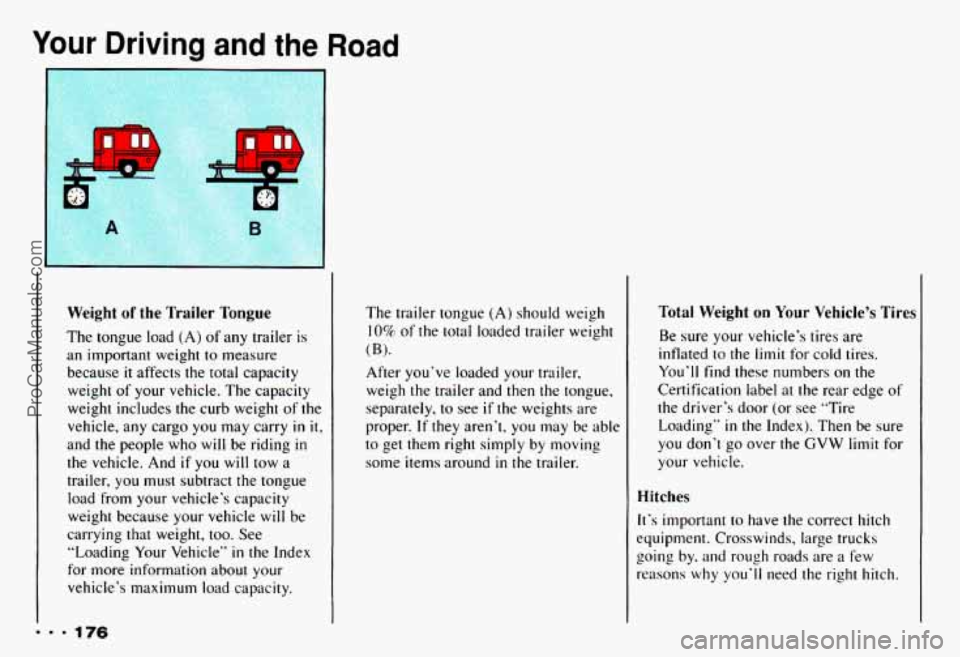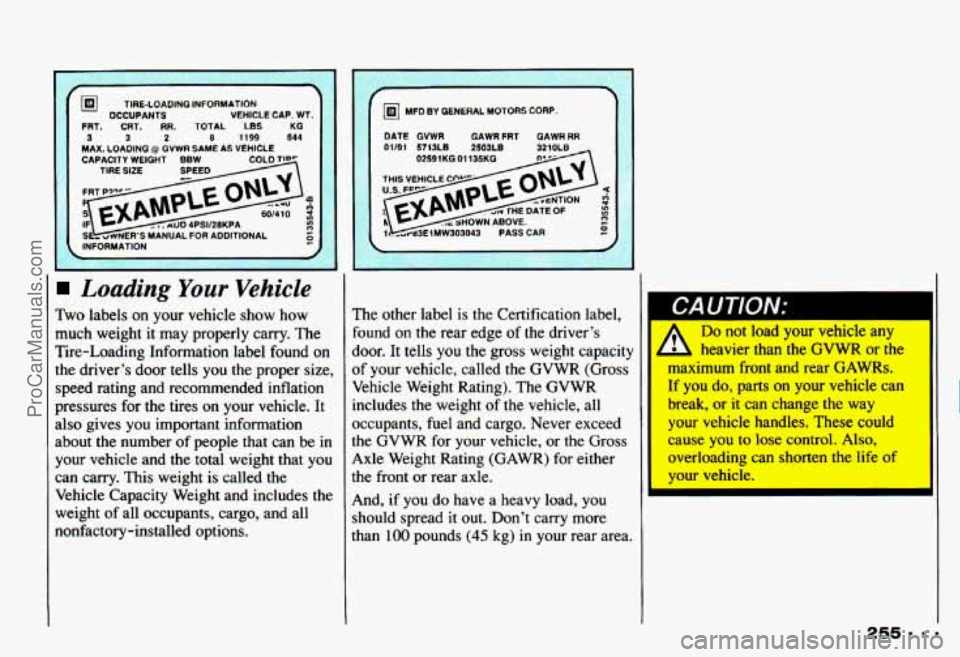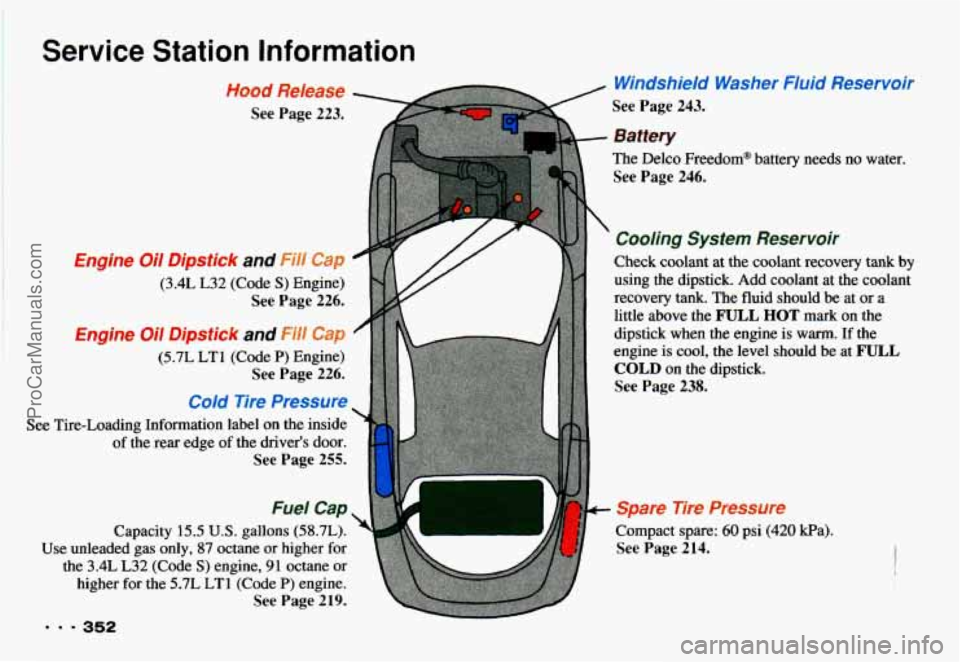Page 178 of 358

Your Driving and the Road
I NOTICE:
AAtnage your vehicle and result i~
jtly repairs not covered by you.
warranty.
To pull a trailer correctly,
follow the advice
in this section.
I
Your vehicle can tow a trailer if it is
equipped
with the proper trailer towing
equipment.
To identify what the vehicle
trailering capacity
is for your vehicle, you
should read the information in “Weight
of the Trailer” that appears later
in this
section. But trailering is different than just
driving your vehicle by itself. Trailering
means changes
in handling, durability, and fuel economy.
Successful, safe
trailering takes correct equipment, and
it has to be used properly.
That’s the reason for this section, In it are
many time-tested, important trailering
tips and safety rules. Many of these are
important for your safety and that of your
passengers.
So please read this section
carefully before you pull a trailer.
Load-pulling components such as the
engine, transmission, wheel assemblies,
and tires are forced to work harder against
the drag of the added weight. The engine
is required to operate at relatively higher
speeds and under greater loads, generating extra
heat. What’s more,
the
trailer adds considerably to wind
resistance, increasing the pulling
requirements.
If You Do Decide to Pull a Trailer
If you do, here are some important points.
There are many different laws having
to do
with trailering. Make sure your
rig
will be legal, not only where you
live but also where you’ll be driving.
A good source for this information
can be state or provincial police.
ProCarManuals.com
Page 180 of 358

Your Driving and the
Weight of the Trailer Tongue
The tongue load (A) of any trailer is
an important weight to measure because
it affects the total capacity
weight of your vehicle. The capacity
weight includes the curb weight
of the
vehicle,
any cargo you may carry in it,
and the people who will be riding in
the vehicle. And if you will tow a
trailer, you must subtract the tongue load from your vehicle‘s capacity
weight because your vehicle
will be
carrying that weight, too. See
“Loading Your Vehicle”
in the Index
for more information about your
vehicle’s
maximum load capacity.
Road
The trailer tongue (A) should weigh
10% of the total loaded trailer weight
(E).
After you’ve loaded your trailer,
weigh the trailer and then the tongue,
separately, to see
if the weights are
proper.
If they aren’t, you may be able
to get them right simply
by moving
some items around
in the trailer.
Total Weight on Your Vehicle’s Tires
Be sure your vehicle’s tires are
inflated to the
limit for cold tires.
You’ll
find these numbers on the
Certification label at the rear edge of
the driver’s door (or see “Tire
Loading”
in the Index). Then be sure
you don’t go over
the GVW limit for
your vehicle.
Hitches
It‘s important to have the correct hitch
equipment. Crosswinds, large trucks
going
by. and rough roads are a few
reasons
why you’ll need the right hitch.
ProCarManuals.com
Page 259 of 358

CAPACITY WEIGHT BBW TIRE SIZE
INFORMATION
Loading Your Vehicle
Two labels on your vehicle show how
much weight it may properly carry. The
Tire-Loading Information label found on
the driver’s door tells
you the proper size,
speed rating and recommended inflation
pressures for
the tires on your vehicle. It
also gives you important information
about the number of people that can be in
your vehicle and the total weight that
you
can carry. This weight is called the
Vehicle Capacity Weight and includes the
weight of all occupants, cargo, and all
nonfactory-installed options.
DATE GVWR GAWRFRT GAWR RR 01/91 5713LB ZS03LB <. .
v)
The other label is the Certification label,
found on
the rear edge of the driver’s
door. It tells you the gross weight capacity
of your vehicle, called the GVWR (Gross
Vehicle Weight Rating). The GVWR
includes the weight of the vehicle, all
occupants, fuel and cargo. Never exceed
the GVWR for your vehicle,
or the Gross
Axle Weight Rating (GAWR) for either
the front or rear axle.
And,
if you do have a heavy load, you
should spread it out. Don’t carry more
than
100 pounds (45 kg) in your rear area.
Do not load your vehicle any
- L heavier than the GVWR or the
maximum front and rear GAWRs.
If you do, parts on your vehicle can
break, or
it can change the way
your vehicle handles. These could
cause you to lose control.
Also,
overloading can shorten the life of , ,
II
ProCarManuals.com
Page 267 of 358

Wheel Replacement
Replace any wheel that is bent, cracked or
badly rusted.
If wheel nuts keep coming
loose, the wheel, wheel bolts, and wheel
nuts should be replaced. If the wheel
leaks air out, replace
it (except some
aluminum wheels, which can sometimes
be repaired). See your Chevrolet dealer
if
any of these conditions exist.
Your dealer
will know the kind of wheel
you need. Each new wheel should have the same
load carrying capacity, diameter, width,
offset, and be mounted the same way as
the one it replaces.
If you need to replace any of your wheels,
wheel bolts, or wheel nuts, replace them
only with new
GM original equipment
parts. This way, you
will be sure to have
the right wheel, wheel bolts, and wheel
nuts for your Chevrolet model.
CAUTION:
Using th-t
wheels, wheel bolts, or wheel
nuts on your vehicle can be
dangerous. It could affect the
braking and handling
of your
vehicle, make your tires lose air and
make you lose control.
You could
have
a collision in which you or
others could be injured. Always use
the correct wheel, wheel bolts, and
wheel nuts for replacement.
263 = 9
ProCarManuals.com
Page 356 of 358

Service Station Information
Hood Release
See Page 223.
Engine Oil Dipstick and Fill Cap
(3.4L L32 (Code S) Engine)
See Page 226.
Engine Oil Dipstick and Fill Cap
(5.7L LT1 (Code P) Engine)
See Page 226.
Cold Tire Pressure
See Tire-Loading Information label on the inside
of the
rear edge of the driver's door.
See Page 255.
Fuel Cap
Capacity 15.5.U.S. gallons (58.7L).
Use unleaded gas only, 87 octane
or higher for
the 3.4L
L32 (Code S) engine, 91 octane or
higher
for the 5.7L LT1 (Code P) engine.
See Page 219.
Windshield Washer Fluid Reservorr
See Page 243.
Battery
The Delco Freedom@ battery needs no water.
See Page 246.
Cooling System Reservoir
Check coolant at the coolant recovery tank by
using the dipstick. Add coolant at the coolant
recovery tank. The fluid should be at
or a
little above
the FULL HOT mark on the
dipstick when
the engine is warm. If the
engine is cool, the level should be at
FULL
COLD on the dipstick.
See Page 238.
_?are Tire Pressure
Compact spare: 60 psi (420 kPa).
See Page 214.
ProCarManuals.com